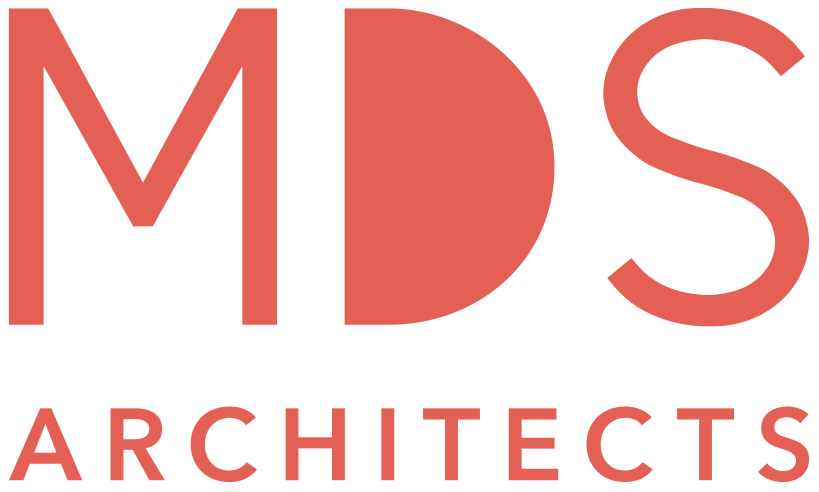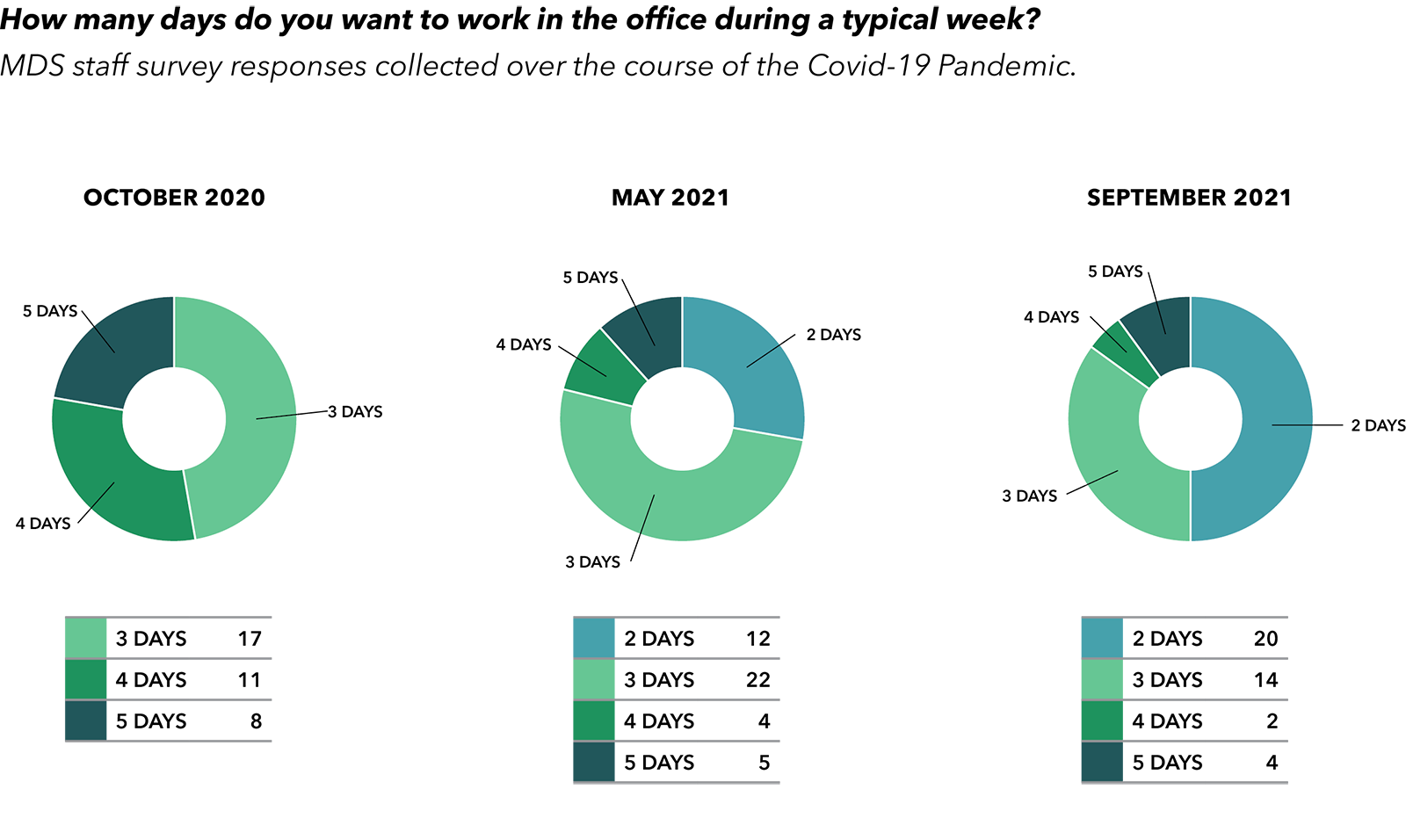mds moves: Preparing for the Change
DESIGN INSIGHTS
By Meaghan Kennedy, IIDA, NCIDQ, Senior Interior Designer
As the workforce and MDS starts to return to a regular hybrid work schedule, it is not simply a documented hybrid work policy that will make hybrid work successful, but a culture and change management that supports this change. A policy will cover expectations, however as always in human resource-based policies, a firm’s culture will define behavior, not policy. Managers set expectations and the unwritten rules shape how employees thrive.
Over the past 19 months, office-based employees have shifted from their day-to-day in-office grove to a work-from-home one. Some have found home is better for concentration, while others find working in office allows for better work-life boundaries. The future of hybrid work allows for greater autonomy when employees are able to craft their schedules and work locations to fit their workstyles and productivity. But how do companies encourage employees to not only adopt new practices that meet their personal needs but also work in ways that support the organization’s mission?
How do companies encourage employees to not only adopt new practices that meet their personal needs but also work in ways that support the organization’s mission?
staff surveys
As MDS finalized its plan to move to a smaller space than it currently occupied, discussions with staff on how they saw the future of their work life were essential. MDS conducted multiple surveys over the next 19 months, as the design for the office was in process and finalized.
Understanding how the staff were set up for remote work was important, as were expectations on how many days per week staff hoped to be in the physical office. Surveys gave insight on how MDS could honor individuality in the new hybrid work model by asking staff their concerns about coming back to the office and into one without assigned desks. Questions such as “what will bring you back into the office” helped reaffirm the types of spaces desired and what might draw staff back to the workplace.
The surveys allowed for anonymous submission of concerns about the hybrid work model and the move. They also provided multiple touch points for MDS leadership to understand whether their communications about the new space and workstyles were easing concerns or raising new ones. By asking the same questions over four surveys in 19+ months, MDS was also able to gauge how individual’s comfort in returning to the workplace changed with the pandemic’s highs and lows.
Collecting data on how employees desired to work was only one part of the plan to make the downsize and change to a hybrid work model successful. The second part involved upgrading our technology to support the flexibility employees desired, and MDS leadership required, to make a smaller footprint successful. Pre-pandemic, MDS had adequate technology to support the organization’s workstyle. However, there were many wish list items that would allow greater flexibility, security and collaboration.
Technology Upgrades
When the world woke up in March 2020, and we all found ourselves working from home, MDS already had a system and procedures in place to meet remote work challenges. Employees had the tools to connect remotely to their computers and staff were allowed to work from home on snow days, for example, and when they needed flexibility to work around personal appointments and family care needs. When the firm migrated to all remote work, some flaws became evident. Staff were agile and communicated best practices for working remotely, while MDS’s work continued to be efficient and successful. However, the strain on technology fast-tracked some planned technology upgrades.
Over the past 19+ months of Covid, our in-house IT team and our IT consultants have coached employees on how to best use their personal devices to connect to remote desktops. The firm outfitted employees’ home offices with devices, monitors, and accessories to make working from home more productive. The team tackled moving portions of the server to the cloud to reduce physical space in the office. This allowed the reclaimed server space to be repurposed as usable collaboration space.
As the plan for the new office took shape, MDS’s IT team fast-tracked moving the remaining items to the cloud and outfitting all employees with MDS-provided laptops. Laptops for each employee support the in-office flexibility — enabling staff to work at a variety of locations, without having assigned desks. The laptops also provide important security enhancements — enabling employees to refrain from using personal devices to connect to the server, which keeps MDS more secure and the employees’ home devices used only for personal use.
In addition to personal technology and server infrastructure, MDS needed tools to support desk reservations. After lengthy research, demos, and conversations, the team selected Robin, a local workplace software platform. Its web- and app-based platform supports on-the-go desk reservations, as well as conference room reservations, providing greater integration of the whole workplace. MDS rolled out the Robin software two weeks prior to its move so that staff could interact with the platform and get comfortable reserving desks. Staff can reserve a desk two weeks in advance and meeting rooms one month in advance.
Robin Platform for MDS’s Collaborative Workplace
a New hybrid framework
The workforce was ready with new laptops and IT infrastructure to support the hybrid work model, but what policies would support our team as we navigated an uncharted office culture? The Associates group of MDS were tasked with creating the guardrails the team would use as staff returned to the office in a different way than many had left it.
How the team would work in this hybrid approach was a bit of a guess at this point. But without a written policy, what resources and guidelines would the team reference when met with new questions as to how one works? An unassigned desk policy opened questions such as “How do you leave the desk at the end of the day,” and “Where would team based materials be stored.”
The Associates strove to create a framework of hybrid work policies as a starting point rather than a stagnant policy afraid to change as our hybrid work culture evolves. The policy outlines virtual meeting etiquette, shared desk protocol and a policy of no eating at your desk. The eating-at-your-desk policy was in response to feedback of concerns of cleanliness and a way to encourage low stakes connection between the team over a meal or snacks in the kitchen.
The policy and Robin software were rolled out during a staff meeting. The following week, a town hall meeting was scheduled to allow staff members to ask questions and bring concerns to ensure the policy was meeting the needs of the team. To keep the policy relevant and responsive, MDS’s Post Occupancy Evaluation group have created a structured feedback loop with periodic surveys to staff as well as one-on-one conversations via our mentorship program to understand what is successful as a one-size-fits-all approach will not succeed.
With the cultural changes, policies, and technology to support our new work model in place the final piece was the design of the space that will be MDS’s new home. Tune in for the next issue to learn about the design!
About Meaghan Kennedy, IIDA, NCIDQ
Meaghan Kennedy is a senior interior designer at MDS Architects where she focuses on workplace and education projects. She is the recipient of the 2021 IIDA New England Star Award, past president of IIDA New England, and chairs IIDA New England’s Design Leaders Network.





